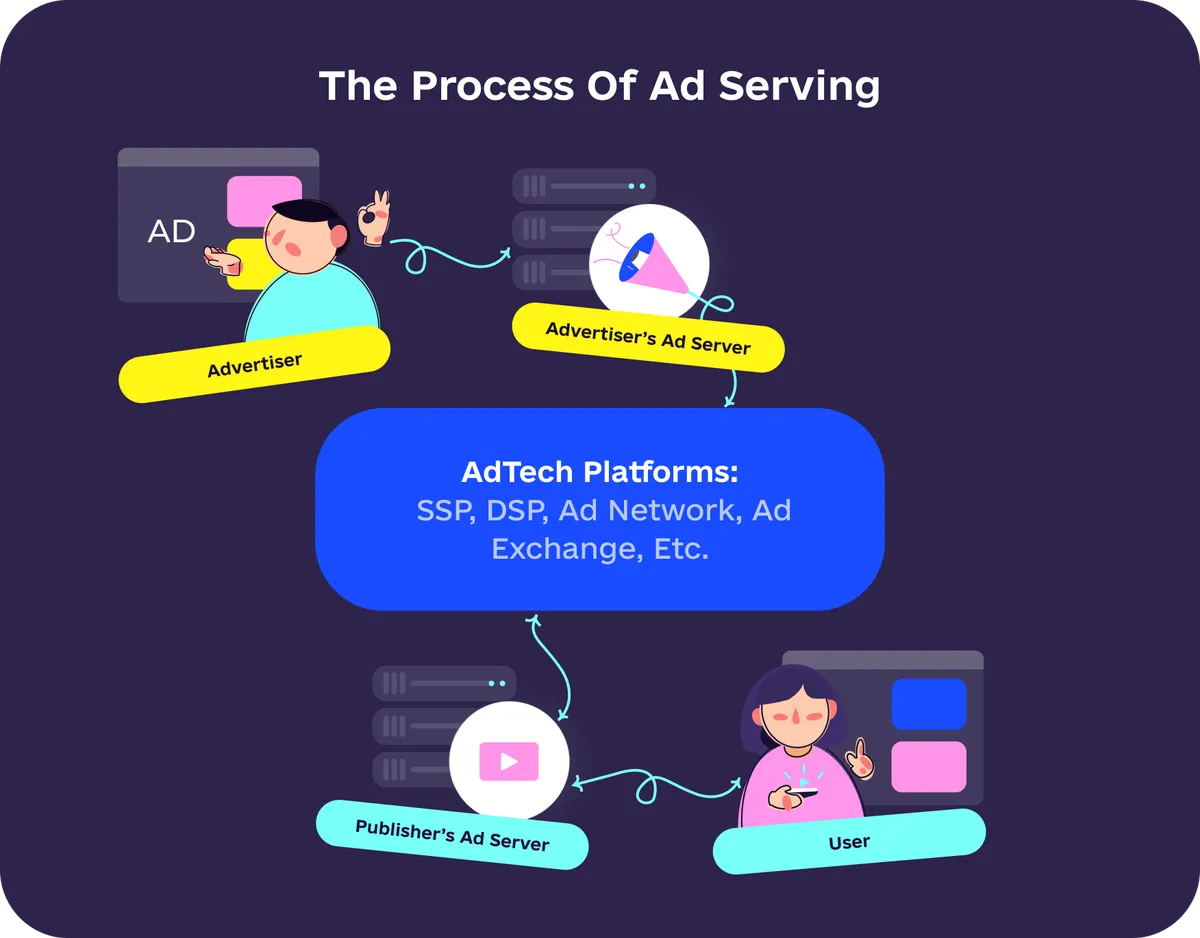While everything seems to be more or less simple in the case of, for instance, social media marketing, programmatic advertising is much more sophisticated. This ecosystem involves multiple components and participants, and ad servers are on the list.
But what is ad serving? What are the different types of servers? What challenges should be considered? To help you navigate the ever-evolving AdTech landscape, we have prepared a detailed guide on ad serving technology. Keep reading to learn more about the ad serving process.
Key Takeaways:
Ad servers enable the delivery, optimization, and management of digital ads across a variety of paid channels.
Building your own ad server from scratch is an expensive and time-consuming process, but choosing a white-label solution is a way to enter the market much faster.
Limited customization is among the key challenges associated with white-label platforms.
A White Label Ad Exchange from Attekmi is fully customizable, so you get a platform tailored to your unique needs.
What is an ad server?
First and foremost, let’s clarify the meaning of an ad server. It is a system responsible for managing, delivering, and optimizing digital ads across paid channels like websites or mobile apps.
The ad server definition can be divided into two key categories:
An advertiser’s ad server: tools for hosting, rendering, and tracking advertising content.
A publisher’s ad server: tools for distributing the content and managing ad inventory.
Note that an ad exchange and a server are different things, even though they “cooperate”. For instance, exchanges send commands to servers after a winning bid is identified.
Many businesses also explore solutions around what is white label ad server to expand their digital advertising capabilities.
As for ad serving costs, these may be publisher ad server fees, third-party tracking fees, and so on.
Types of ad servers
To better understand how ad serving works, let’s review several types of ad servers.
First-party ad servers
First-party servers are mainly used by media owners. They provide publishers with full control over the inventory and allow for selling ad slots to advertisers directly.
Third-party ad servers
These are used by advertisers and agencies to manage campaigns across multiple platforms. Additionally, such servers provide performance metrics.
Programmatic ad servers
Using real-time bidding and data-driven targeting, these servers enable real-time media buying and selling.
Video ad servers
These servers focus on the delivery and optimization of video ads. Other format-specific servers exist as well: for contextual ads, native advertisements, and so on.
White-label ad servers
Such solutions allow you to launch your own server in the shortest time possible. There is no need to develop such a solution from scratch. Instead, a platform gets rebranded so that it looks and feels like it was created by your business.
What is ad serving?
The ad serving meaning is as follows: that is a software-based cycle of delivering digital ads to users. This process guarantees that the right content will be shown to the right users.
How does ad serving work? It relies on the rules outlined by both marketers and publishers and requires the involvement of ad servers.

As you can see, an ad exchange performs as an intermediary, ensuring reliable connection with servers and effective ad delivery.
Key challenges in ad serving
Now that the ad serving definition is clarified and you know what a server is, let's explore some of the challenges related to the process.
An ad exchange for publishers allows you to join the programmatic ecosystem, and there are two ways to do this. The first one is to build a solution from scratch. It is expensive and time-consuming, but there is one significant benefit — you keep everything under control.
An alternative approach is to get a white label ad exchange and become a part of the ad serving process quickly. By doing so, you can start earning on media trading promptly, but there are still several things to keep in mind. Additionally, many companies choose ad operations outsourcing to streamline the process and reduce overhead costs. This approach allows businesses to focus on their core competencies while leaving the technical complexities of ad operations to experts.
Customization
When it comes to white label platforms, customization is among the most significant challenges, even though it is not directly linked to ad serving. Rebranding the platform is usually not a problem, but updating it with specific features on request may be more complicated. Therefore, finding the right white label solution that will meet all your needs in full may take a lot of time.
Integrations
To start media trading, you need more than a working ad exchange — supply and demand partners are key players of the programmatic ecosystem, so you need to connect them to your platform. However, prior to this, you have to find partners, which can be especially challenging if you are new to programmatic advertising.
Besides, it is important to keep in mind that the modern AdTech industry offers an entire set of integration options, like header bidding, OpenRTB, and so on. To meet the needs of your future partners, your white label solution needs to have multiple integration capabilities. Otherwise, if it is limited, for example, only to header bidding, you will have fewer opportunities to drive media trading income.
Optimization and monitoring
For ad exchange owners, ad optimization is different than for marketers. For example, you will not have to track the conversion rates — that is the task of your demand partners.
However, you still need to understand how your white label solution performs, what ad formats and traffic types are the most effective, which connections bring the most profit, and so on. By collecting and analyzing such data, you will be able to optimize the performance of your platform, ensure better outcomes for your partners, and, as a result, increase your revenue. The analytics capabilities of a white label platform may be limited, so it can be complicated for you to get all the essential insights and optimize your solution in the right way.
Ad fraud prevention
Ad fraud is a significant challenge for anyone related to the advertising industry. Thus, marketers aim to eliminate fake clicks, while publishers want to prevent malicious creatives from being displayed on their websites. You, as an ad exchange owner, need to ensure a safe environment for your partners, which means that your white label solution must be equipped with traffic and demand scanners. Additionally, it should also be compliant with data processing standards and privacy regulations.
However, ad fraud techniques evolve continuously, meaning that even a secure white label platform may get certain weaknesses at some point. If this happens and leads to any issues, your reputation can be affected.
Limited ad serving capabilities
Effective programmatic advertising relies on the correct performance of ad exchanges, servers, SSPs, and DSPs. Precise targeting is among the key factors for all the parties involved. While advertisers need to understand their customers to be able to reach the right users at the right time, you, as an ad exchange owner, have to match your demand and supply connections correctly.
White label solutions usually come up with different ad formats and traffic channels. However, this is not enough, and if other ad serving features and settings are limited, it may be complicated for you to build a loyal partner base and drive income. When building an ad exchange solution on your own, you can equip it with all the features you need, but this process is time-consuming and requires a deep understanding of how programmatic advertising works. In turn, white label platforms may not meet your needs.
SPO functionalities
Supply path optimization (SPO) is among the most popular AdTech trends nowadays, as advertisers search for ways to ensure brand safety. Thus, an ad exchange solution should have sufficient SPO capabilities to help you create a safe ecosystem for your partners and drive stable income. Again, if you build an ad exchange from scratch, you are in full control of everything. But SPO features of a white-label solution may not be enough.
Data privacy and regulatory compliance
The whole AdTech industry is adopting the privacy-first approach, and international regulations are getting stricter. Ensuring full compliance can be a very challenging task, whether you are going to launch a white-label solution or build such a platform from the ground up.
Lack of technical skills
Choosing a white label ad exchange means that you will not have to develop your solution from scratch, which is already a benefit. However, you will still need to operate this solution, and if you and your team lack technical skills, doing this can be challenging. Developers of white label platforms usually aim at making them as intuitive to use as possible, but the programmatic environment is still rather complex on its own. You have to understand how it works and explore every functionality of your platform to maximize its efficiency. This may take a lot of time, especially if you are only entering the programmatic market.
How a white-label ad exchange from Attekmi helps overcome these challenges
Dealing with all the above-mentioned challenges is possible; you only need to select a reliable provider that will help you ensure effective ad serving. Take a look at the benefits of Attekmi’s solution.
Complete customization
Choosing a White Label Ad Exchange solution is a way to create a marketplace that will fully meet your needs. It is completely customizable, from UI personalization to custom on-request functionality development.
A variety of integration options
Our list of integration options includes OpenRTB 2.6, header bidding, JS tags, VAST to VAST, VAST to All, VAST to RTB, and connectors for specific integrations.
Brand safety and regulatory compliance
You can integrate a range of scanners to fraud-proof your system, as well as leverage advanced filtering settings to ensure a safe ecosystem for your demand and supply partners. Besides, our White Label Ad Exchange is compliant with GDPR, CCPA, and other standards.
All the essential formats and environments
The list of available ad formats includes banner, audio, video, native, and CTV ads. The supported traffic channels are in-app, mobile web, desktop, and CTV.
Precise targeting
By applying a range of targeting settings, you can match supply and demand connections effectively and optimize the performance of your platform.
Easy analytics and optimization
A detailed analytics dashboard makes it easy to monitor performance and detect weaknesses and opportunities in real time.
Ultimate support
Our team delivers extensive support and guides you all the way through. Moreover, we act proactively to help you maximize the efficiency of your strategy.
With Attekmi, StreamKey managed to double its profit within 2 months, and you can achieve the same results. Feel free to take a look at other case studies to learn more about our solution and understand its effectiveness.
Does Attekmi seem like the right choice? Then let’s get in touch!
FAQ
How does ad serving work?
The process of ad serving involves advertisers, publishers, their servers, and AdTech platforms like SSPs, DSPs, ad exchanges, ad networks, and so on. Thanks to the exchange of signals and commands between these components, the winning ad is identified and delivered to a user.
What is the difference between an ad server and an ad exchange?
In simple words, ad servers perform on the sides of publishers and advertisers, while an ad exchange is a “place” where the auction happens. Servers are aimed at managing creatives or inventory, and an ad exchange enables these creatives to take part in the auction and reach the relevant ad space.
Why choose a white label ad exchange for ad serving?
The key benefit is that choosing a white label ad exchange is a way to join the programmatic ecosystem within a very short period of time without investing extensive amounts of time and money in developing it from scratch. Additionally, credible solutions have already been tested by multiple clients, minimizing risks for every new owner.
 By Anastasiia Lushyna
By Anastasiia Lushyna